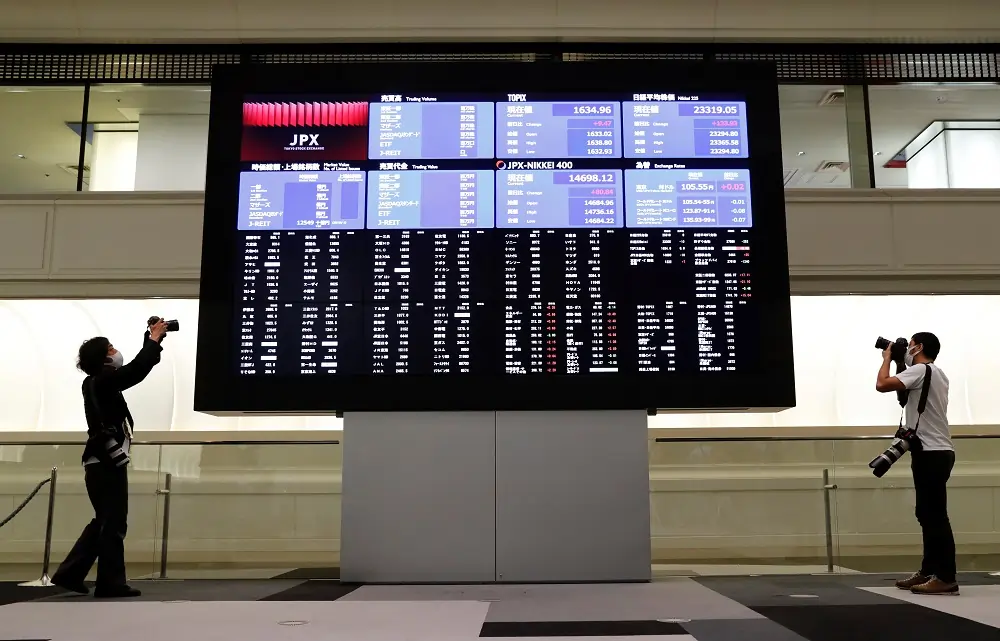
LONDON/SYDNEY (Reuters) -Global shares drifted on Friday in the absence of guidance from Wall Street, which was closed for the Thanksgiving holiday the previous day, but they were still on course for their best month since November 2020.
An indecisive Asia session extended to Europe, with the Stoxx 600 share index trading flat. Both S&P 500 futures and Nasdaq futures were also little changed.
In geopolitical news, Israel and Hamas started a four-day ceasefire on Friday and the militants were set to release 13 Israeli women and child hostages later in the day, the first sign of detente in the near seven-week-old war.
MSCI’s index of global shares was flat, but still headed for a monthly gain of 8.5% after investors grew increasingly confident that U.S. interest rates have peaked, with the market narrative shifting to the timing of cuts..
The U.S. central bank has raised benchmark borrowing costs by more than five percentage points since March 2022 as part of a global monetary tightening cycle.
“Weaker (economic) data and weaker inflation in the U.S. has given markets hope you are going to start to see rate cuts,” said Peter Doherty, investment management director at Arbuthnot Latham in London.
“But the debate is whether we should be taking profits now,” he added, given the potential for a “re-acceleration of U.S. growth,” after the world’s largest economy confounded recession forecasts throughout 2023.
Despite optimism having surged across global markets this month, there may also be a lull ahead as investors position their portfolios for 2024, some analysts said.
“You get the talk of the so-called Santa rally, but often times Santa rally doesn’t really occur in the last two weeks of December,” said Shane Oliver, chief economist at AMP.
“So we could have a couple of weeks with the markets sort of just meandering around and lacking direction.”
U.S. 10-year Treasury yields, which set the tone for borrowing costs worldwide, were up 3 bps at 4.4704%, still comfortably below the 5% milestone reached last month.
Minutes from the latest Fed policy meeting signalled there would not be more hikes unless progress against taming inflation faltered.
Germany’s 10-year bund yield rose for a third session, to 2.655%, reflecting pushback from European Central Bank officials against speculation they were ready to start thinking about cutting rates.
The dollar index < =USD>, which measures the U.S. currency against six peers, was on the back foot on Friday at 103.71, nearing a three-month low as rate cut bets reduced the appeal of holding dollars.
In Europe, however, markets reflected a growing pessimism about central banks loosening monetary policy.
Euro zone bond yields were on track to close the week broadly higher after money markets reflected less certainty about an April 2024 rate cut by the ECB than they had a week ago.
Germany’s benchmark 10-year bund yield was little moved on Friday at 2.639% but has risen 5bps in a week.
In the UK, where the Bank of England is now viewed as having to keep interest rates at a 15-year high until late next summer, sterling perched near a 2-1/2 month top at $1.256.
In Asia, Japan’s Nikkei share index climbed 0.7%, charging back towards a 33-year high hit on Monday.
Data on Friday showed that Japan’s core consumer inflation picked up slightly in October, although by less than expected.
Mainland China’s CSI 300 index dropped 0.7% to its lowest close in more than a month, reflecting investor concern about a property slump and sluggish economy.
On Friday, foreign investors sold a net 6.2 billion yuan ($859.79 million) of mainland Chinese shares via the stock connect channel, the biggest daily outflow in more than a month.
Oil prices were steady after tumbling more than 1% on concerns over a delayed OPEC+ meeting. Brent crude futures were virtually flat at $81.68 a barrel. [O/R]
Gold was stable at $1,992 per ounce.
($1 = 7.2111 Chinese yuan renminbi)
(Reporting by Naomi Rovnick and Stella Qiu. Editing by Sam Holmes, Robert Birsel, Toby Chopra and Susan Fenton)


